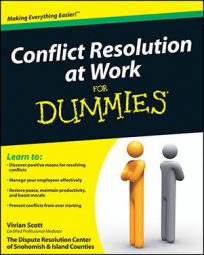If you’re a manager dealing with a conflict in the workplace (and what workplace doesn't have some conflict?), you need a strategy to approach and defuse the disagreement. You can effectively mediate the conflict by following this process:
Do preliminary planning, scheduling, and room setup.
Getting the right people in the right room at the right time is a good first step to creative problem-solving. Do some leg work upfront to determine who’s involved in a conflict. Then put some effort into creating an inviting environment so your employees have the best shot at successfully resolving their issue.
Greet parties and discuss the process.
Setting ground rules, discussing your role as a neutral facilitator (which may be new to your employees) and letting the parties know that you’re open to helping them resolve their differences are all ways to demonstrate that this conflict — and its resolution — belongs to them.
Share perspectives.
Refining the art of reflecting and reframing helps you identify core values, neutralize emotional language, and demonstrate that listening to each other’s point of view is far more productive than listening to rebuttals.
Build an agenda together.
Creating a cooperative agenda after hearing each other’s perspective lets employees build a list of topics that acts as a compass for the rest of their meeting and provides a yardstick for their progress.
Negotiate in good faith.
Giving employees the space to brainstorm and make proposals for solutions that benefit both of them can create remedies that are longer lasting and more durable.
Hold private meetings if necessary.
Meeting privately gives each employee an opportunity to share sensitive information, practice how he might ask for what he needs, apologize for his role in the conflict, or acknowledge the positive aspects of his working relationship.
Craft agreements, with details.
The best agreements are detailed agreements. Leaving anything to the imagination can cause trouble down the road, so crafting agreements with an eye for detail gives employees the boundaries and certainty they seek.
Monitor follow-through.
Looking for signs that things are going well or tuning into cues that there’s more work to be done gives you an opportunity to praise your employees for what they’re doing well and to coach them on next steps.

